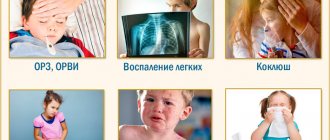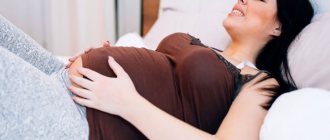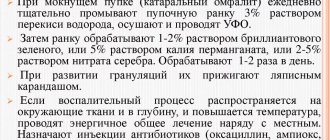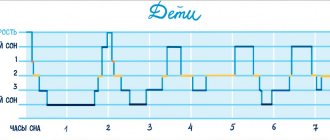Where do they come from?
The term “growing pains” itself is conditional.
Why? There is an established medical fact: many children 3-4 years old experience evening or night pain in their legs. They go away after some time and then return again at the age of 6-12 years.
But as for the reason that causes these pains, there is no firm certainty, but only hypotheses. Presumably, they appear during periods of active child growth. The bones of the legs quickly increase in length, which causes tension in the muscles and tendons, hence the pain.
The second hypothesis is that the child’s daily activity - running, jumping, climbing, and other outdoor games - creates a large load on the leg muscles, so they may hurt in the evening or at night.
This hypothesis is supported by the fact that 50% of children have leg pain at any age. However, not everyone grows at the same speed, so pain, if it is caused by growth, may have its own age calendar for each child.
There is another hypothesis. Some experts suggest that this type of pain is present in those children who develop restless leg syndrome as they age.
A person experiences discomfort in the lower extremities, most often in the evening and at night. The patient constantly changes the position of his legs, cannot calm down and fall asleep. The origin of this disorder is still not very clear.
One way or another, the phenomenon of children’s night pain in the legs has been given the name “growing pain.”
Causes of leg pain in children
Many factors can cause pain - from harmless to very dangerous.
Ignoring complaints of pain and changes in gait can lead to long-term negative health consequences. The reasons why a child’s legs hurt can be different:
- kidney diseases, which are accompanied by edema and congestive processes;
- diseases of the cardiovascular system;
- disruption of growth processes, including due to lack of nutrients in the body;
- congenital and acquired pathologies of muscles and joints;
- injuries.
Some diseases, including infectious arthritis, develop rapidly and can quickly lead to significant joint destruction or even blood poisoning. Therefore, if there are complaints of sore legs, parents should first examine the child themselves, and then, if necessary, call an ambulance. Emergency medical care is required for:
- a sharp general or local increase in temperature;
- swelling of the limb;
- leg deformities, changes in the shape of joints;
- unnatural muscle tension, cramps;
- changes in skin color, including darkening, blueness, or redness.
If no signs of pathology are detected, these may be so-called “growing pains.” Unpleasant sensations in this case are associated with the rapid development of muscles and joints. This is a temporary phenomenon and does not pose a health hazard. It must be taken into account that growing pains cannot be unbearable or interfere with movement. Such symptoms already indicate the development of a particular disease.
Orthopedic disorders
If a child has a leg pain for no apparent reason, it may be due to orthopedic diseases. The following can cause unpleasant sensations that are not accompanied by swelling, changes in skin color and the appearance of bruises:
- spinal deformity;
- joint dysplasia;
- flat feet;
- clubfoot.
In the case of orthopedic pathologies, pain increases with increased load on the affected joint or in a certain body position. Deformation of the joints and spine can cause compression of nerves and blood vessels, which causes symptoms such as “current” in the body, coldness of the legs, and sensory disturbances. In rare cases, a rare disorder called tethered cord syndrome can cause discomfort in the back and legs. Infectious lesions of joints Infectious diseases of muscles and joints lead to severe pain. Infectious arthritis often occurs several weeks after an illness: ARVI, sore throat, flu or food poisoning. Synovitis - inflammation of the joint capsule - develops after injury or infection. In infectious diseases of the musculoskeletal system the following are observed:
- temperature increase;
- increasing swelling;
- intoxication;
- nausea;
- severe pain;
- muscle spasms and cramps.
The joints most commonly affected by infectious arthritis are the hips and knees. If a child has a swollen knee and a fever, you should urgently call an ambulance. After completion of the main treatment, rehabilitation may be required to prevent complications and relapses of the disease. Diseases of the blood vessels and heart In pathologies of the heart and blood vessels, blood flow is disrupted, which can cause intense pain. In this case, frequent dizziness, weakness, bulging or sunken veins in the legs, and cyanotic skin may occur. Constant coldness of the feet also signals poor circulation. Injuries and fatigue from active games Often, knee pain in a child is associated with physical activity. Bruising, swelling and scratches indicate damage to the limb. Injuries that are accompanied by:
- increasing swelling;
- deformation of the joint or the entire leg;
- the appearance of a pulsating hematoma.
A slight aching pain that intensifies with pressure is a sign of simple muscle fatigue and goes away after a warm bath and rest.
How do they manifest themselves?
Photo from consumerlab.com
Most often, the child’s muscles hurt in the legs and thighs, and the area of the knee joints. Sometimes this may result in a headache or stomach pain.
For different children, these pains may have different frequency: for one they bother them every night for a long period of time, for another they happen only occasionally.
For some, their legs hurt more often in the evening, when going to bed, and prevent them from falling asleep; for others, the pain wakes them up in the middle of the night, and the child begins to cry in bed. Most often, such episodes occur a few hours after falling asleep, although an attack of pain is quite possible late at night. Children usually complain by pointing to the front or back of the knee, just above the knee, or to the shin.
Usually the attack of pain lasts 10-15 minutes, and the next morning and throughout the day it does not remind itself at all.
Sometimes the child wakes up several nights in a row, but more often such painful attacks occur only from time to time over several weeks or months, then disappear for some time. Subsequently they may resume.
What to do if your child’s legs hurt?
Self-administration of antibiotics and painkillers can only harm health: cause the development of secondary diseases or accelerate the progression of the underlying pathology. In case of intense or persistent pain, you should consult a pediatrician or orthopedist. A comprehensive diagnosis will help answer the question of why a child’s legs hurt:
- X-ray;
- MRI;
- CT;
- ECG;
- blood and urine tests;
- collection of intra-articular fluid (in some cases).
Please note: radiography makes it possible to detect only deformation of the joints and spine, but does not provide information about the condition of the spinal cord, nerve endings and blood vessels. Therefore, do not refuse if your doctor recommends tests such as MRI and CT: they will help to accurately determine the cause of the pain.
How can you understand that these are growing pains and not some serious disease?
Photo from medicalnewstoday.com
The main sign, as mentioned above, is that the pain bothers you at night or in the evening, but the child feels normal in the morning and during the day.
The second important sign is pain in both limbs at the same time. If only one leg hurts, a different diagnosis should be assumed.
Another feature of growing pains: large joints (knees) hurt, not the toes.
And, let us remind you once again, if the child is under three (and some experts believe four) years old, then you should also look for another explanation for the pain in the legs.
Growing pains are not dangerous, however, it is better to show your child to a doctor. In case of growing pains, the doctor, examining the patient, will not see anything alarming. In this case, tests and x-rays will be redundant.
Common complaints
Most often, doctors are consulted with complaints of pain in the knees, which is shooting in nature. No less often, children complain of aching legs in the morning or in the evening. Often the baby says that his feet hurt.
If no additional symptoms are added to these complaints, most likely there is no danger or the problem is easily remedied. But swollen and reddened joints, pain that does not go away throughout the day, accompanying aching or sharp pain in the spine, hip joint, general malaise, and retarded physical development should alert both the doctor and parents. Such children need a thorough examination, which will include x-rays, ultrasound of joints and blood vessels, and MRI.
A full examination with mandatory blood tests should also be performed in case of spasms of the calf muscle. This condition is referred to as “cramped leg.”
If your child has cramps in his legs every day and more than once, if this problem bothers you at night, you should definitely consult a doctor as soon as possible.
In what cases is it necessary to consult a doctor?
verywellhealth.com
- As mentioned above, if a child under 3 (4) years of age complains of pain in the legs.
- If your child experiences prolonged pain in one limb.
- If pain in the legs is combined with lameness or a noticeable deterioration in general condition, an increase in temperature.
- If your child complains that it hurts to walk.
- If the joints are swollen and the skin in the areas where the pain is localized is red.
- If pain is accompanied by weakness, weight loss.
- If the pain is accompanied by a rash.
With these symptoms, the cause of the pain may be arthritis or some infectious disease.
If there is any doubt, it is still better to show the child to a doctor.
Most often, in the absence of a traumatic injury (which suggests a fracture, dislocation or sprain), pain in the legs in children aged 2 to 12 years is the so-called growing pains.
Growing pains are recurring pain in the hip or, less commonly, lower leg. Usually they are double-sided. Despite the fact that on average every fourth child experiences growing pains, the cause is not fully understood. There is a certain hereditary predisposition, but no specific genetic markers have been identified. In addition, it is known that although these pains occur at an age when the child is actively growing, pain episodes may not be associated with the period of most active growth.
Growing pains appear sporadically - there are periods without pain at all, and sometimes the pain can last for several days, weeks and even months. More often, the pain intensifies after intense exercise during the day. Typically, growing pains appear in the evening and at night, and sometimes they can even wake up the child. Their intensity can also vary, some children even groan in pain.
Massage, a warm bath, and activities that can distract the child (reading books, talking) help relieve such pain. Sometimes, if the pain is very severe, it is possible to use painkillers (ibuprofen, paracetamol).
As a rule, when examined by a pediatrician, children with growing pains do not detect any pathology.
However, there are alarming symptoms, if they appear, you should consult a doctor.
- Unilateral pain (only in one leg) may be a sign of bone or ligament pathology.
- The absence of intervals or periods without pain may indicate some kind of chronic disease; a thorough examination of the child is necessary.
- Swelling of the joints, redness of the skin over them, limitation of movements in the joints - such symptoms can be observed with juvenile rheumatoid arthritis and other systemic diseases (dermatomyositis, systemic lupus erythematosus, etc.).
- Swollen lymph nodes, fever, or a rash may be signs of an infectious disease or the initial manifestations of cancer affecting bones or joints.
- The child’s general poor health: lethargic, inactive, refuses to eat/play - such manifestations are always alarming and require a thorough examination.
Psychosomatic reasons
Oddly enough, in children the appearance of pain syndrome is very interconnected with their mental and emotional state. Therefore, it happens that a comprehensive examination does not reveal any compelling reasons for concern and then you can visit a psychologist. Severe fear, constant stress in which the child is, pressure on him from adults may well cause pain in the lower extremities.
In this case, the pain will be episodic and quite severe. It is noteworthy that psychosomatic pain appears in circumstances reminiscent of those in which the disease first started. You can help your child by reducing his level of daily stress. Positive emotions and eliminating the causes of fear or anxiety lead to the gradual disappearance of unpleasant sensations.
In what cases is it better to seek medical help immediately?
Complaints of pain in the morning or throughout the day are a good reason to consult a pediatrician or general practitioner. Perhaps a small patient will be advised to donate blood to check the calcium level in the body. Bone growth and density depend on this chemical element. Doctors may also advise checking the concentration of vitamin D. It is responsible for the regulation of calcium metabolism and is presented in two main forms: cholecalciferol (vitamin D3) and ergocalciferol (vitamin D2). The body produces the first itself, and receives the second from food. A lack of vitamin D in fast-growing young children leads to rickets, a disease of the bone and nervous systems caused by metabolic disorders.











